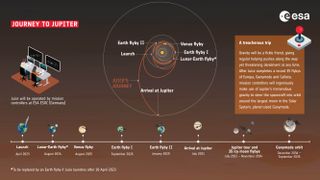12.04.2024

What happened?
Seven years from now, in April 2031, ESA’s Juice mission will fly past Jupiter’s moon Callisto, offering scientists a tantalising glimpse at the mysterious, cratered alien world.
That might seem far off, but in the world of spacecraft operations, it is never too early to start preparing.
Teams at ESA’s ESOC mission operations centre in Germany recently ‘tricked’ Juice’s engineering model into thinking it was already at Callisto in order to put the mission’s autonomous navigation software to the test.
Why was this necessary ?
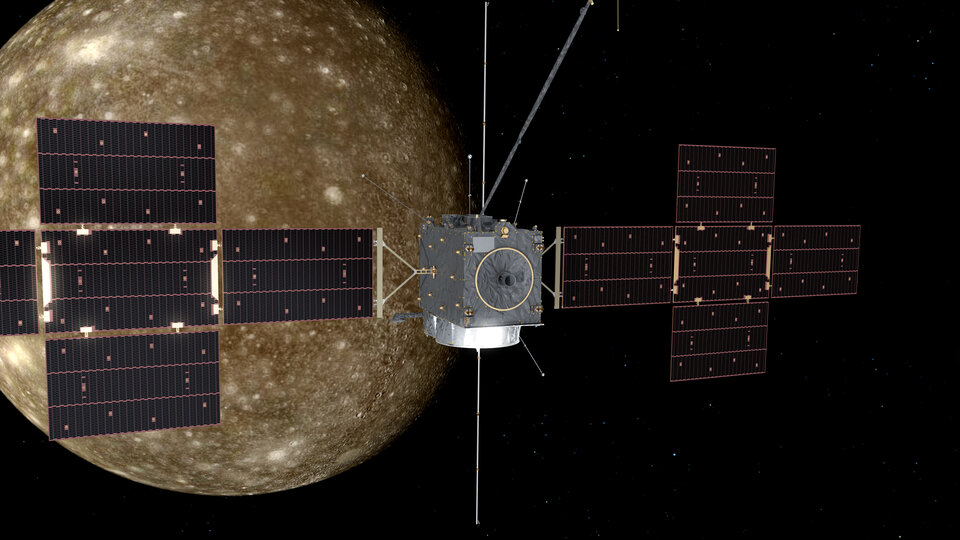
When Juice arrives at Callisto, the large communication delay between Earth and the Jupiter system will mean that it cannot afford to wait for a reply from mission control if something goes wrong.
While we have a good idea of where Callisto will be in April 2031, we don’t know its position precisely enough to guarantee that Juice’s trajectory will take it through Callisto’s gravitational field in exactly the right way to line it up perfectly for high-accuracy scientific measurements.
In the time it takes to send and receive messages between Jupiter and Earth, the direction that Juice is pointing its remote sensing instruments could drift so far off course that science could be missed, and key mission objectives impacted.
Even a tiny discrepancy could be terrible for science, as some of Juice’s instruments need to be pointed at specific regions of Callisto within a tiny fraction of a degree in order to make their measurements.
“We need Juice to be able to react with its own ‘eyes’ and its own ‘brain’,” says Ignacio Tanco, Juice Flight Operations Director. “When Callisto appears in the field of view of its navigation camera, it needs to be able to identify important features on the moon’s surface, rotate itself to point its instruments at them, and then continue rotating to keep them in view as it flies past.”
What did you do?
Teams at ESA fly spacecraft to new and exciting destinations across the Solar System. To train for important activities and to help diagnose and solve issues experienced by spacecraft millions of kilometres away, they use a one-of-a-kind replica that remains on Earth. This ‘engineering model’ is an exact copy of the hardware, software, electrical systems and instruments that are sent into deep space.
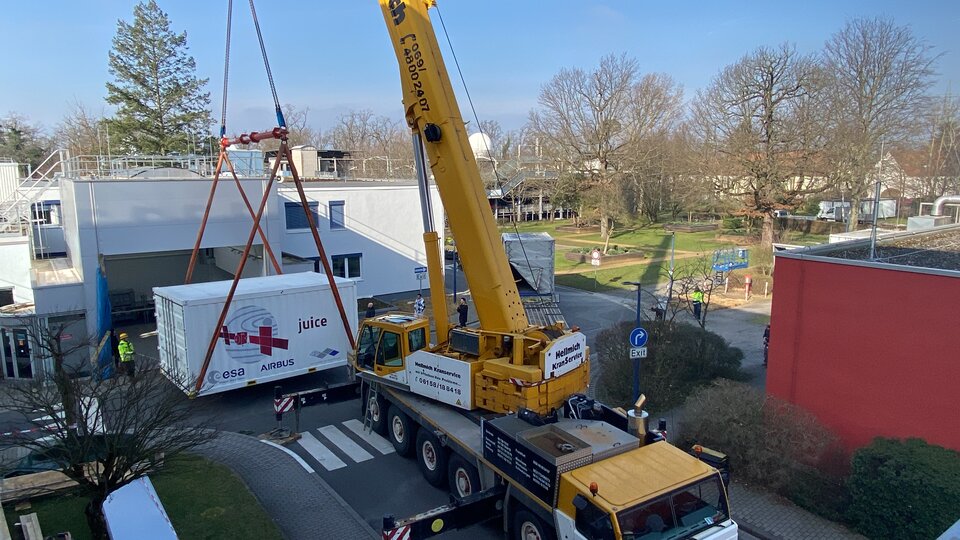
The Juice team used its engineering model to test the autonomous navigation software that will keep Juice on track at the Jupiter system.
They ‘tricked’ it into believing it was at Callisto by projecting a series of images of the moon onto its faithful replica of the spacecraft’s navigation camera to see how it would respond.
These high-resolution images, generated by a computer model, depicted Callisto in the exact orientation and phase that Juice will see it when it arrives seven years from now.
“It was not as simple as preparing images in advance and playing a video in front of the navigation camera,” says Giulio Pinzan, ESA Spacecraft Operations Engineer, who oversaw the activity.
“The navigation software had to react to these images. If it noticed that it was approaching Callisto at the wrong angle or facing slightly the wrong direction, it had to attempt to correct these errors without our help.”
“That meant the view of Callisto had to react to the spacecraft’s actions in real time. We effectively strapped an immersive virtual reality headset to Juice’s camera and let it move around independently inside this virtual space.”

How did it go?
The teams from ESA and Juice's manufacturer, Airbus, allocated three days for the Callisto flyby test. The spacecraft operators, scientists and mechanical, electrical and software engineers all expected to spend days encountering and solving issues before finally achieving a clean flyby in which Juice reacted exactly as they wanted.
To make this test even more challenging, they didn’t have access to one of the most important tools in the spacecraft operations toolkit. Usually, before a complex test like this is run on the spacecraft’s physical engineering model, it is first run on an entirely digital software simulator of the spacecraft that has no physical parts.
This is where most issues are encountered and resolved, and tests are only run on the physical engineering model when operators already have a good idea of what to expect.
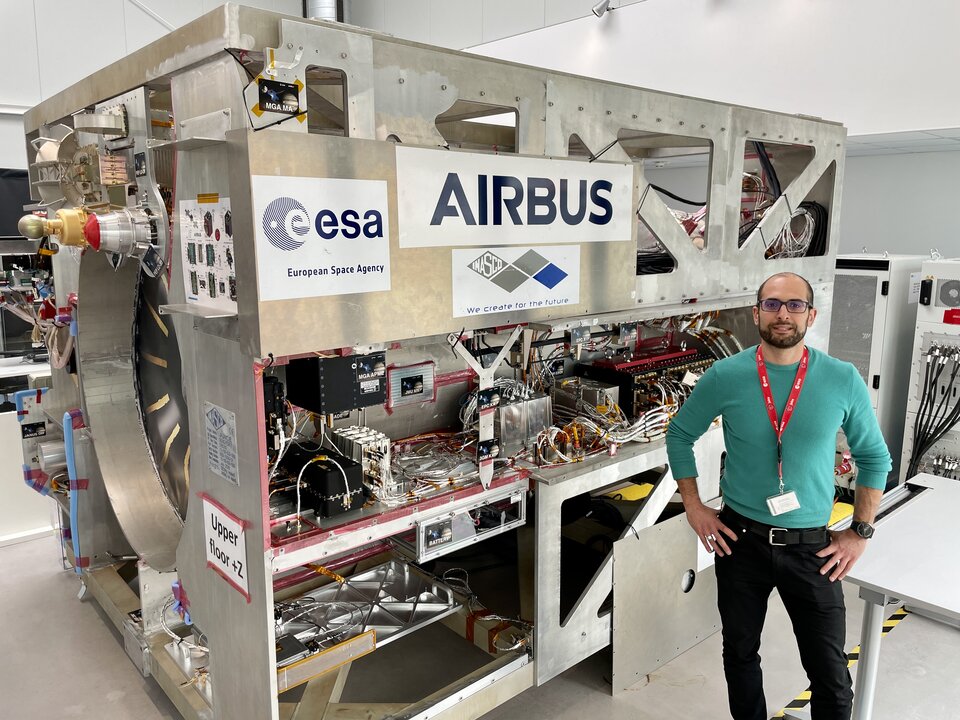
“But this scenario is so complex that it is currently impossible to simulate with the Juice software simulator,” says Giulio Pinzan. “We were flying into this test completely blind.”
Yet, despite their expectations, the team succeeded on the very first attempt on day one. Juice’s navigation software locked on to the correct regions of Callisto, kept its instruments pointed directly at them, and safely maintained the correct trajectory as it navigated through the demanding flyby.
“We really have to praise our Flight Dynamics team, in particular,” says Giulio. “Their mathematical calculations were spot on and enabled us to cruise through a clean flyby on the very first attempt despite the lack of experience they would usually gain from experimenting with the software simulator. It was amazing, really. They surprised even us.”
"The Airbus team also did a remarkable job setting up the engineering model in time for the test, while at the same time providing us with all the details that we needed to operate the autonomous navigation system correctly."
What happens next?
The Callisto flyby is one of the most demanding scenarios that Juice will face and is one of the most difficult to set up and carry out with the engineering model.
The model was transported from Airbus in France to ESOC in Germany in February. With the successful completion of this final test, it is now fully set up, the ESA teams are fully trained on how to use it, and it has officially been handed over.
The Juice team now need to confirm that the flight model behaves in exactly the same way as the engineering model by carrying out a similar test in space. However, the only opportunities to track a large object with Juice’s navigation camera will come during its planetary flybys.
The upcoming lunar-Earth gravity assist in August this year is not an option for this test. During this double flyby, Juice will swing past the Moon and then Earth less than 24 hours later in order to steal energy from both bodies in quick succession. It is a very delicate manoeuvre that has never been attempted before and all hands will need to be ready to react to any anomaly at a moment’s notice.
Stay tuned to @esaoperations and @ESA_Juice on X for celebrations of Juice’s launch anniversary around 14 April, and for updates as Europe’s Jupiter mission briefly returns to Earth in August 2024.
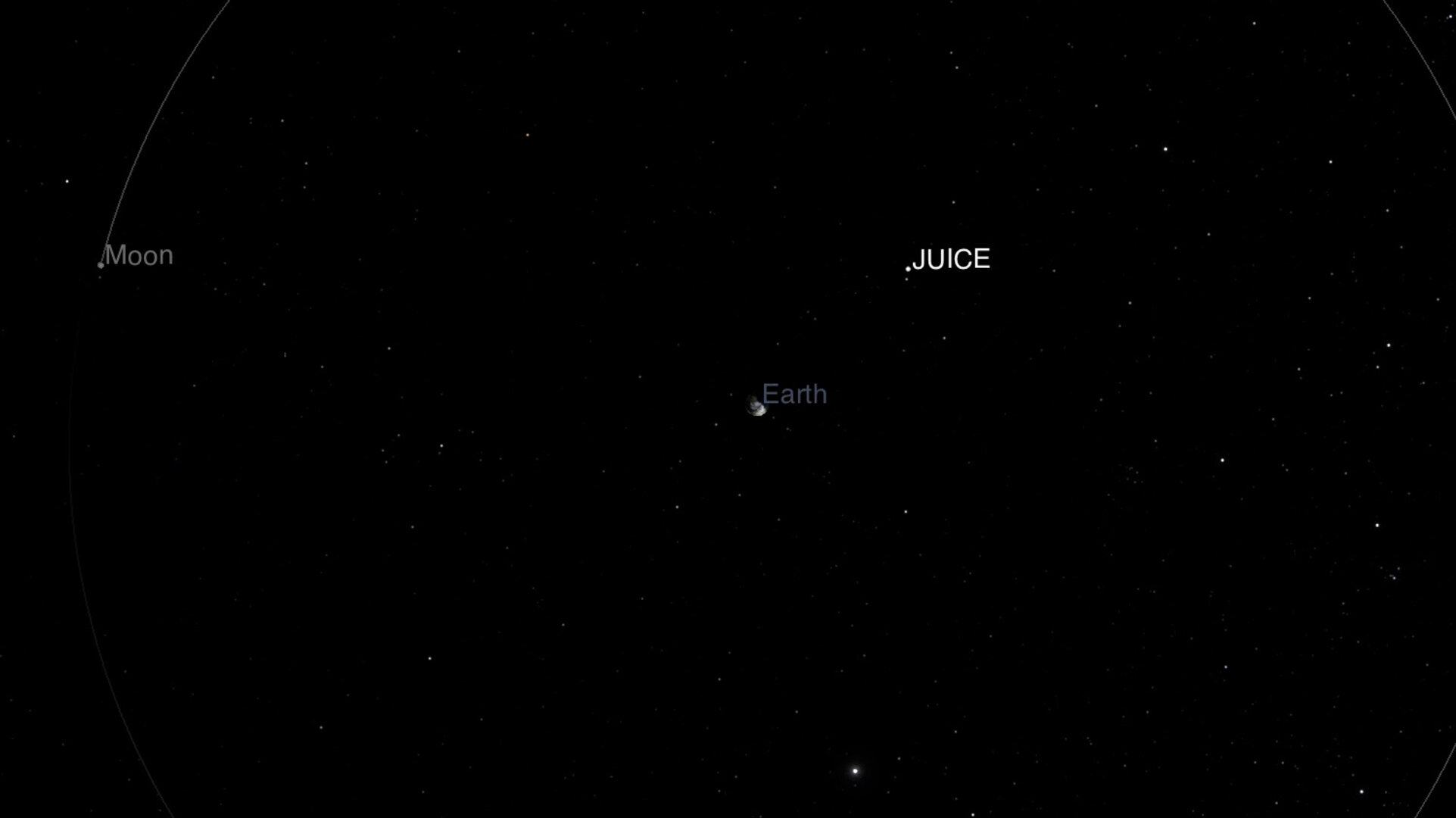
Access the video
How JUICE mission may find water on other planets and moons

JUICE mission’s RIME transmitter. Credit: NASA/JPL-Caltech.
Water on other planets and moons may be a crucial clue to finding extraterrestrial life. But finding water, even within our own solar system, is proving to be very difficult.
It’s a problem which NASA and the European Space Agency (ESA) is hoping to resolve with the JUICE [JUpiter ICy moons Explorer] mission launched a year ago on 14 April 2023.
Its objective is to study Jupiter and three of its Galilean satellites: Ganymede, Callisto and Europa. These are all icy worlds which show promise as potential sites of life outside Earth within our own solar system.
Like Saturn’s Enceladus, these moons of Jupiter are suspected to have oceans of liquid water beneath their icy crusts.
On board JUICE are a suite of remote sensing instruments.
One instrument, called RIME, for Radar for Icy Moon Exploration, is designed to sense liquid water beneath the surface of planetary bodies.
It is an adaptation of ground-penetrating radar (GPR) which has already proven useful in finding liquid water under thick ice on Earth and Mars.
Not only can the technology detect liquid water, it can also determine the chemistry of the water beneath the ice. Deeper radar penetration suggests less salt in the ice.
Such radar systems will also be aboard NASA’s Europa Clipper mission which is due for launch later this year.
Dr Elena Pettinelli of Italy’s Roma Tre University, this information will improve understanding of the distribution of liquid water in the solar system. “There’s much more water than we thought 20 or 30 years ago, and it’s really interesting to use this technique to try to understand where the water could be.” Pettinelli was part of the team that discovered a stable body of liquid water under glaciers at the Martian South Pole.
Cosmos readfers can hear, via Zoom, Pettinelli discuss RIME in a talk at the European Geosciences Union General Assembly EGU24 next week.
Quelle: COSMOS
----
Update: 16.07.2024
.
Juice’s lunar-Earth flyby: all you need to know

ESA’s Jupiter Icy Moons Explorer (Juice) will return to Earth on 19–20 August, with flight controllers guiding the spacecraft first past the Moon and then past Earth itself. This ‘braking’ manoeuvre will take Juice on a shortcut to Jupiter via Venus.
What is happening?
It’s a double world first. The first-ever lunar-Earth flyby, and the first-ever double gravity assist manoeuvre. It will change Juice’s speed and direction to alter its course through space, but it’s a daring feat; the slightest mistake could take Juice off course and spell the end of the mission.
Following Juice’s launch in April 2023, this lunar-Earth flyby is the first step in the spacecraft’s waltz through the Solar System on its journey to Jupiter.
During the flyby, Earth will bend Juice’s trajectory through space, ‘braking’ it and redirecting it on course for a flyby of Venus in August 2025. From that moment on, the energy boosts will begin, with Juice being whizzed up by Venus and then twice by Earth – the space exploration equivalent of drinking three back-to-back espressos.

Why does it need to happen?
Jupiter is on average ‘just’ 800 million km away from Earth. Without an enormous rocket, sending Juice straight to the giant planet would require an impossible 60 000 kg of onboard propellant. And then Juice would need to be carrying an enormous additional amount of propellant to slow itself down enough to go into orbit around Jupiter once it arrives, rather than simply zipping straight past and off into outer space.
So Juice is taking the scenic route, using the gravity of other planets to carefully adjust its trajectory through space and ensure it arrives at Jupiter with the right speed and direction. This incredibly complex, constantly evolving route has been carefully planned out by Juice’s dedicated mission analysis team over the last 20 years.
Somewhat counterintuitively, using the lunar-Earth flyby to slow Juice down at this point in its journey is actually more efficient than using the flyby to speed it up. If we had instead used this flyby to give Juice a boost towards Mars, we would have had to wait a long time for the next planetary flyby. This first ‘braking’ manoeuvre is a way of taking a shortcut through the inner Solar System.
Find out more about why Juice’s journey to Jupiter is so long and complex

How are we making it happen?
Mission operators have already adjusted Juice’s path to ensure that it arrives first at the Moon, then a day later at Earth, at precisely the right time, with the right speed, and travelling in the right direction. They are confident of success, but this is a risky challenge that no other space mission has ever faced before.
As Juice’s Spacecraft Operations Manager, Ignacio Tanco puts it: “It’s like passing through a very narrow corridor, very, very quickly: pushing the accelerator to the maximum when the margin at the side of the road is just millimetres.”
Juice will come extremely close to both the Moon and Earth, meaning that real-time pinpoint accuracy is required in all navigation manoeuvres. From 17–22 August, Juice will be in continuous contact with ground stations around the world. Every second of the way, through day and night, operators will keep a careful watch on the data coming down from Juice, making any tiny adjustments needed to keep the spacecraft on the right course.
Bonus science!
As if steering Juice around two enormous space obstacles wasn’t enough, ESA will also be activating the spacecraft’s ten science instruments as it passes by the Moon and Earth.
The lunar-Earth flyby provides a prime test environment for instrument teams to collect and analyse data from an actual surface in space for the first time. For some instruments, this is the only opportunity to make certain measurements during Juice’s entire eight-year journey to Jupiter. It will give scientists and engineers the chance to calibrate their instruments, smooth out any remaining issues, and who knows, they may even make some surprising scientific discoveries.
The lunar-Earth flyby is particularly crucial for Juice’s Radar for Icy Moon Exploration (RIME) instrument, as RIME data is being disturbed by some electronic noise within the spacecraft.
The flyby of the Moon on 19 August is one of only a few chances before arrival at Jupiter for the RIME team to check how this noise is affecting the instrument’s performance. During the closest approach to the Moon, RIME will have eight minutes to observe alone, with the other instruments either switched off or set to quiet mode. Based on these observations, the RIME team will work on an algorithm to correct the noise problem.


How can you follow along?
A lucky few may even be able to see Juice pass overhead, with the spacecraft flying directly over Southeast Asia and the Pacific Ocean. Powerful binoculars or a telescope will give you the best chance of seeing the spacecraft. Trajectory data can be found here.
Meanwhile, Juice’s two onboard monitoring cameras will be snapping photos throughout the lunar-Earth flyby, which we will be sharing publicly via social media and our Rocket Science blog as soon as they are received on Earth.

Quelle: ESA
----
Update: 28.07.2024
.




